There aren’t many advantages to the weather the UK is currently experiencing. We can only relax, head out with a brolly, and enjoy the flowers. Those un-battered by wind are preserved longer in cooler temperatures and are lasting so much longer than they would usually. That’s a bonus in my book.
Cold Variety Angel’s Trumpet – Brugmansia sanguinea
This flower is simply glorious. It has the Chelsea Pensioner colour scheme – the red the colour of their coats, the gold the colour of their buttons.
Unlike most of the Angel’s Trumpets you see around, this species is to be found in the cloud forests of South America and consequently likes cooler temperatures and shade. I did overwinter it in the greenhouse, where the low temperatures of the winter just gone, prompted it to flower. 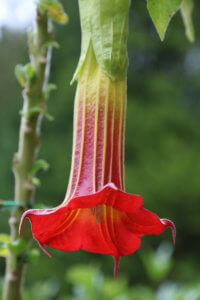
Soon after the coldest temperatures eased I moved it to a shady north-facing spot by the back door so I could admire the flower. Slow motion spring meant I was kept waiting as the flower emerged from its pod with the pace of a dozy snail. As you can see, it was worth the wait.
Unusual primula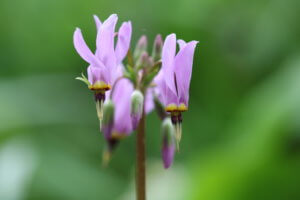
Two unusual primulas are strutting their stuff down in the woodland walk. The first is Primula dodecatheon jeffreyi which has taken 18 months since planting to hit its stride. 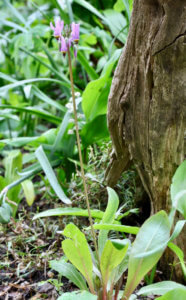
The flower stem is 40cm tall, slender and strong and topped with clusters of violet flowers with fully reflexed flowers. I noticed on twitter this week that Jonathan of The Propagator blog described these as looking like feathered blow pipe darts. I can’t think of a better description.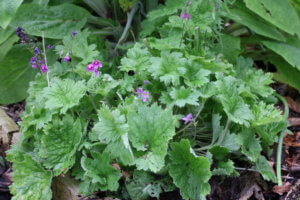
Meanwhile, also a member of the primulaceae family is this Cortusa matthioli. The flowers are just going over but hopefully you can see that they are a pretty cerise. The leaves are fresh green and shaped like those of a hardy geranium.
No Mow May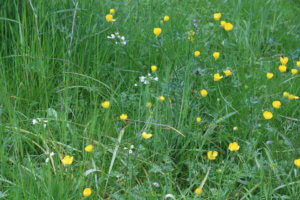
No Mow May is an initiative to encourage people to leave parts or all of their lawns and verges un-mown in may. The aim is to provide a wildflower buffet of nectar for emerging insects. There are several parts of my garden untouched by my mower each and every May, mainly those lawn edges where spring bulbs bloom.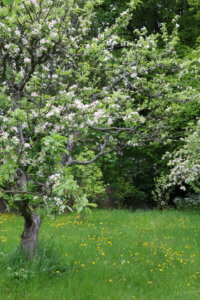
There’s another area of the garden, the orchard meadow, that is untroubled by a mower all spring and summer, save for a narrow path strip around the apple trees. There are few aspects of gardening where doing less creates more but this is one of them. The less I do, the more flowers arrive. Since reducing mowing 2 years ago vetch, buttercups, lady’s smock, lady’s bedstraw, wild garlic, bugle, green alkanet, feverfew and cow parsley have taken hold. It’s lovely to observe which flowers like the shadier damp parts and which the brighter sunnier areas. The insects love it there and so do I.
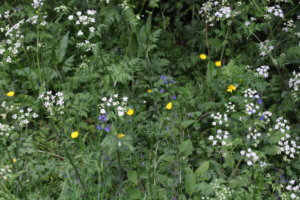
Desolate Veg Patch
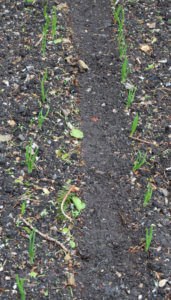
Onions on the way up
I cannot remember a time when my veg patch looked this barren in late May. Usually everything is planted out by now and direct sown beans are starting to climb their poles. I’m not worrying though. Things soon perk up and before long I’ll be outdoors on a sunny day planting out the squash, the sweetcorn, the peas and willing them to get cracking.
The onions were only planted out a couple of weeks ago and are perky and green. I know they’d look more resplendent from an autumn sowing but I just never got round to it. This period in the growing year is often referred to as the ‘Hunger Gap’ – spanning as it does the time between the harvest of the last winter crops and the readiness of new season delicacies. My hunger gap will be lasting a bit longer.
Sweet Peas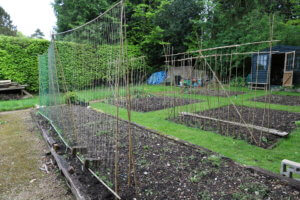
The sweet peas that I sowed in late February were pretty keen to get outside so they were planted out a month ago. They’ve been sulking in the cold and wet but there are signs that they are about to explode out of the blocks.
The sure sign that they’re about to let rip is when the stems turn stop being wimpy and cylindrical and become flat and stocky. Mine are at this point now so I’m expecting big things in the next few weeks. This year, as in previous years, they’ll be climbing up my string cordon structure.
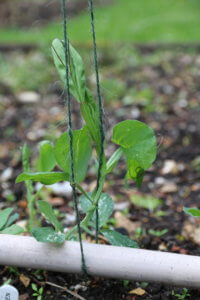
Aubretia wall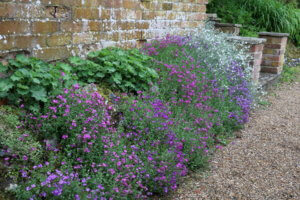
Despite the grey days this aubretia is sparkling like a thousand amethysts. I can claim no credit for this area at all. I didn’t plant these, and they need no maintenance at all, but on a rainy day I’m thankful to whoever first nestled those plants into gaps in this wall.
This seasonal diary is part of a weekly link-up of garden bloggers from around the world, called Six on Saturday. For more information and links to other blogs crammed with gardening activity, check the blog of host The Propagator.



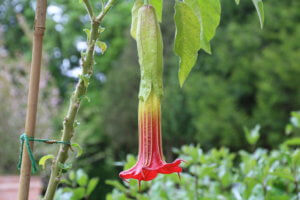
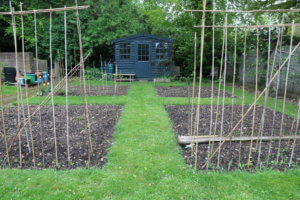
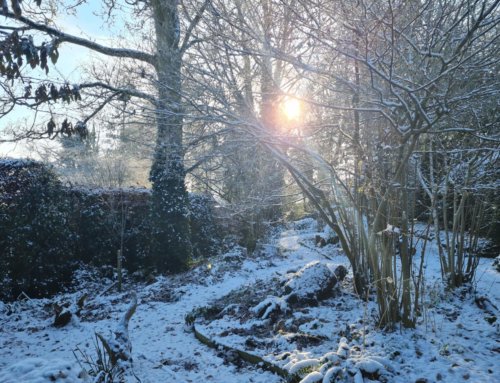
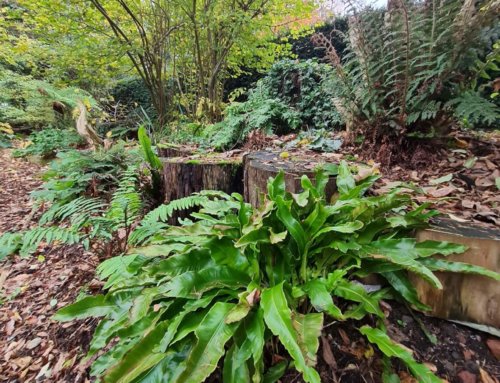
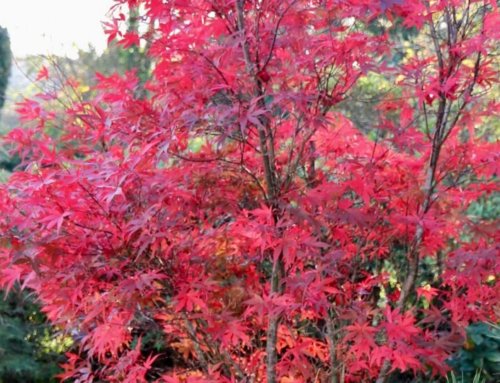
The Angel’s Trumpets are lovely,
It’s been a strange spring weather-wise but as you say, spring flowers have certainly lasted a lot longer than usual. Wow to the Angel’s Trumpet and Primula dodecatheon jeffreyi. Aubretia really is a cheerful plant – I must get some more.
Amazing colour of the brugmansia… This will be the next variety of brug I want to grow…
Parts of my allotment are as bare as your veg plot even after planting things out, thanks to the slugs. I’m too impatient. I’m adding the Brugmansia to my wanted list.
There’s something that feels good about letting go in the wilder areas, and it looks lovely too, especially in your orchard setting. We’re also doing No Mow May, it’s an idea that is only just starting to take on in Belgium. I’ve been promoting it on my gardening group! That string cordon structure looks snazzy – my sweet peas have been sulking too, hope they’ll take off in June.
It has been quite unseasonal, April and May more like a March. Watching the various insects is quite a pass time in my garden…I have no lawn to not mow, but I have several types of wild flowers in the mixed planting which the pollinators are attracted to.
I am making a note of the cold tolerant Brugmansia. I love the concept of No Mow May and your observations of all the wildflowers that have appeared in different areas of your garden. The Orchard is particularly lovely and inspires me to establish a wildflower meadow under my recently planted trees.
Snap on the bare vegetable garden and the sulking sweet peas. The weather has just been so unseasonable. Your No mow May grass is looking lovely and meadowy.
I cheer myself up by looking through last years photos of my beautiful garden from this time last year and know that it’s all to come in June!